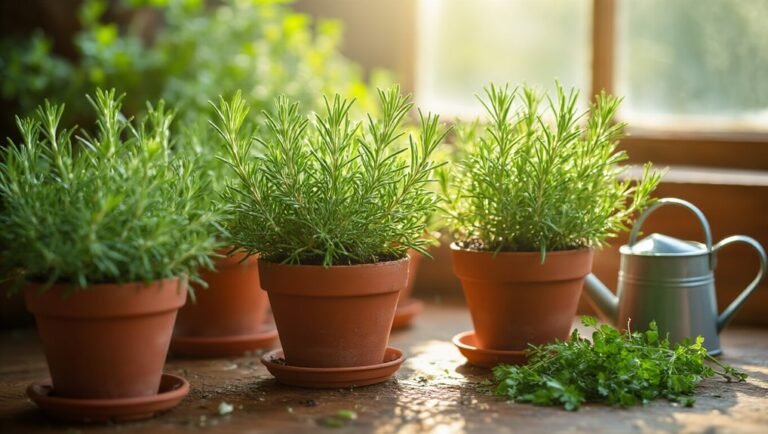To build deep, rich topsoil, you need to focus on improving soil composition and structure. Incorporate organic matter like compost, rotate your crops, and practice cover cropping. These methods enhance nutrient availability and moisture retention, promoting strong plant growth. Avoid compacting soil by limiting heavy traffic and machinery use. By nurturing topsoil, you create a thriving garden environment. Keep exploring to discover more techniques and strategies for maintaining vibrant topsoil.
Key Takeaways
- Prioritize incorporating organic matter like compost to enhance nutrient availability and soil structure for rich topsoil.
- Rotate crops annually to maintain soil health and prevent nutrient depletion.
- Utilize cover crops during off-seasons to enrich and protect the topsoil.
- Apply mulch to retain moisture, regulate temperature, and suppress weed growth effectively.
- Conduct regular soil tests to tailor amendments and avoid over-fertilization, ensuring beneficial microorganisms thrive.
The Importance of Topsoil for Healthy Plants
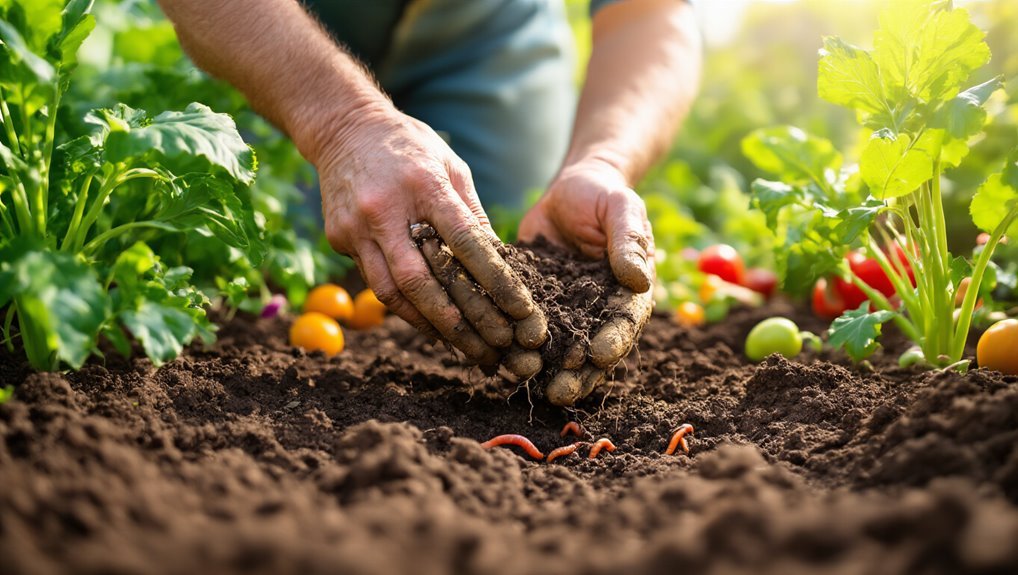
Topsoil is crucial for healthy plants because it’s where the magic of growth happens. It’s the uppermost layer of soil, rich in nutrients, and holds moisture, creating the perfect environment for seeds to sprout and roots to thrive. For gardeners aiming to improve their soil, using a soil sifter or screen can help remove rocks and debris, resulting in finer, more consistent topsoil.
Without quality topsoil, your plants struggle to get the nutrients they need. Think of it as a nurturing bed that supports your garden.
Healthy topsoil not only encourages strong roots but also promotes beneficial microorganisms that help break down organic matter. This process enhances nutrient availability and improves soil structure.
When you invest time in building deep, rich topsoil, you’re setting the stage for vibrant, flourishing plants. For best results, consider using garden soil designed to provide optimal nutrients and support for thriving plants.
Understanding Soil Composition
While you might think of soil as just dirt, understanding its composition reveals a complex ecosystem that supports plant life. Soil consists of minerals, organic matter, air, and water, each playing a crucial role. The balance of these components defines soil health. Outdoor composting systems can be an excellent way to increase organic matter levels in your garden.
| Component | Description | Importance |
|---|---|---|
| Minerals | Sand, silt, clay | Provides structure and nutrients |
| Organic Matter | Decomposed plants and organisms | Enhances fertility and moisture |
| Air | Gases found in soil | Supports root respiration |
| Water | Moisture content | Vital for plant hydration |
| Microorganisms | Bacteria and fungi | Aid in nutrient cycling |
Using a compost bin can significantly boost the organic matter in your garden soil, leading to healthier plants and richer topsoil.
Methods to Improve Topsoil Quality
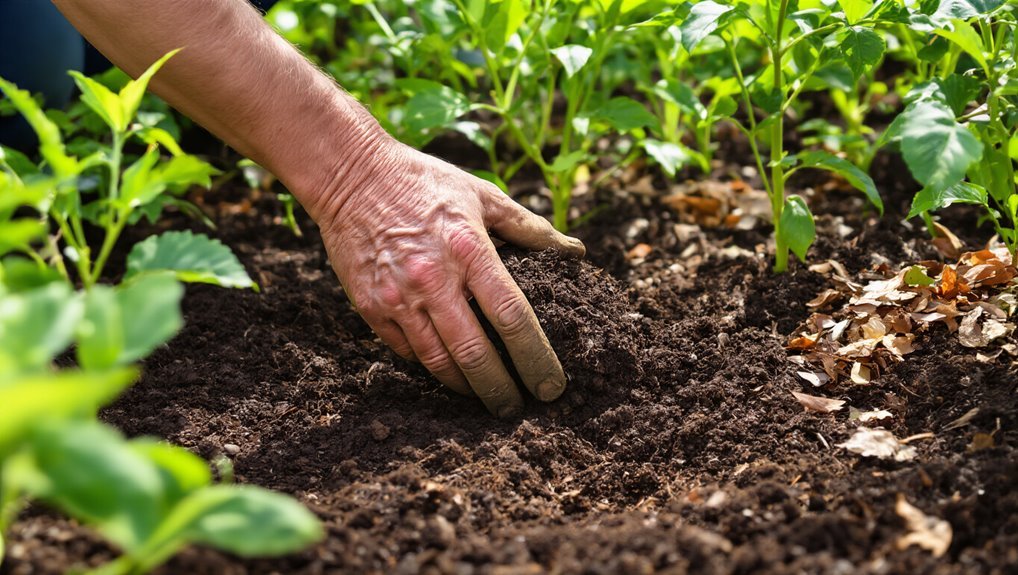
If you want to cultivate a thriving garden or farm, improving topsoil quality is essential. Start by incorporating organic matter like compost or well-rotted manure; this boosts nutrients and enhances soil structure.
Regularly rotating your crops can also prevent nutrient depletion and reduce pests. Practice cover cropping during the off-season to protect and enrich the soil while minimizing erosion. One highly effective way to support soil health and moisture retention is by using mulch, which also helps regulate soil temperature and suppresses weeds.
Avoid over-tilling, as it disrupts soil structure and can lead to compaction. Instead, adopt no-till or minimal-till methods.
Lastly, consider mulching to retain moisture, suppress weeds, and gradually improve soil health as it breaks down.
Using a compost tumbler is an efficient way to create nutrient-rich compost that can be added to your soil, further enhancing its fertility and structure.
The Role of Organic Matter in Topsoil
Incorporating organic matter into your soil practices significantly enhances topsoil quality. When you add materials like compost, mulch, or well-rotted manure, you increase nutrient availability and improve soil structure. For gardeners seeking the most effective results, using a compost thermometer ensures your compost reaches optimal temperatures for decomposition, maximizing nutrient content.
This rich organic content helps retain moisture, making it easier for plants to thrive during dry spells. Additionally, organic matter fosters beneficial microbial activity, which breaks down nutrients and supports plant health.
It also enhances the soil’s ability to hold carbon, contributing to a healthier ecosystem. By regularly amending your soil with organic matter, you create a vibrant environment that promotes deep, rich topsoil, essential for sustainable gardening.
Ultimately, this practice not only boosts your garden’s productivity but also strengthens its resilience against pests and diseases. Using organic mulching materials such as straw is an effective way to add organic matter to your garden while protecting soil from erosion and temperature extremes.
Techniques for Building Depth in Topsoil
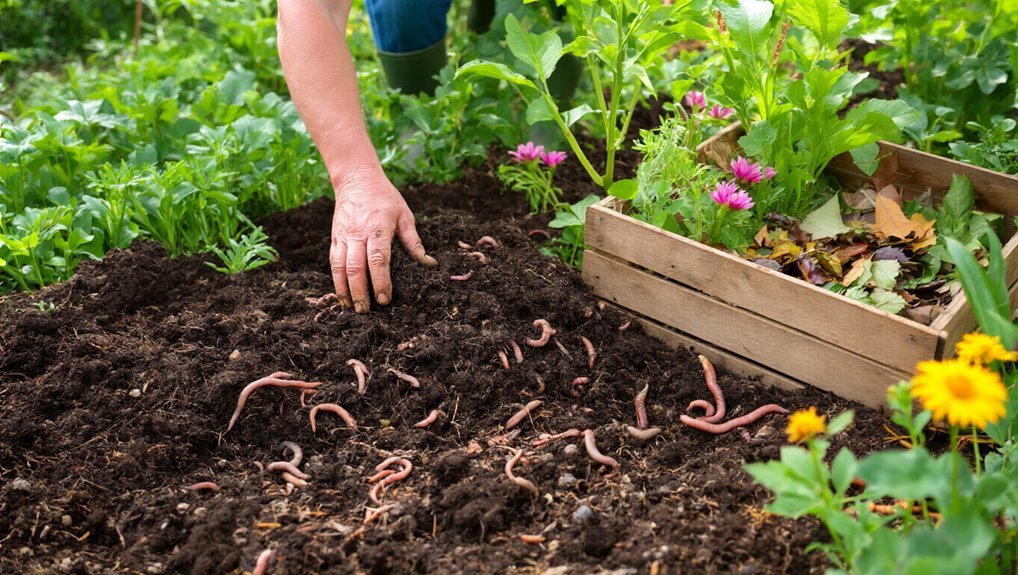
To build depth in your topsoil, you can employ several effective techniques that enhance soil structure and fertility.
Start by adding organic matter, like compost or well-rotted manure, to enrich your soil. Rotate your crops annually to promote diversity and prevent nutrient depletion.
Consider using cover crops to protect and improve soil health during off-seasons. Incorporate mulching to retain moisture and suppress weeds, creating a nurturing environment for soil organisms.
Lastly, practice no-till gardening to minimize soil disturbance, allowing natural processes to flourish.
- Feel the satisfaction of watching your plants thrive.
- Experience the joy of nurturing life from the ground up.
- Discover the magic of rich, dark soil.
- Witness the transformation of your garden.
- Enjoy the bountiful harvests that follow.
Maintaining Topsoil Richness Over Time
While building rich topsoil is an important first step, maintaining its quality over time requires consistent effort and attention.
Regularly adding organic matter, like compost or well-rotted manure, enhances soil structure and nutrient content. Keep an eye on moisture levels; too much or too little can harm your soil’s richness.
Crop rotation is key, as it prevents nutrient depletion and pest buildup. Mulching also helps retain moisture and suppress weeds, protecting your topsoil.
Test your soil periodically to monitor pH and nutrient levels, adjusting your amendments accordingly.
Lastly, avoid compacting your soil by limiting foot traffic in garden areas. With care, you’ll ensure your topsoil remains vibrant and fertile for years to come.
Common Mistakes to Avoid When Improving Topsoil
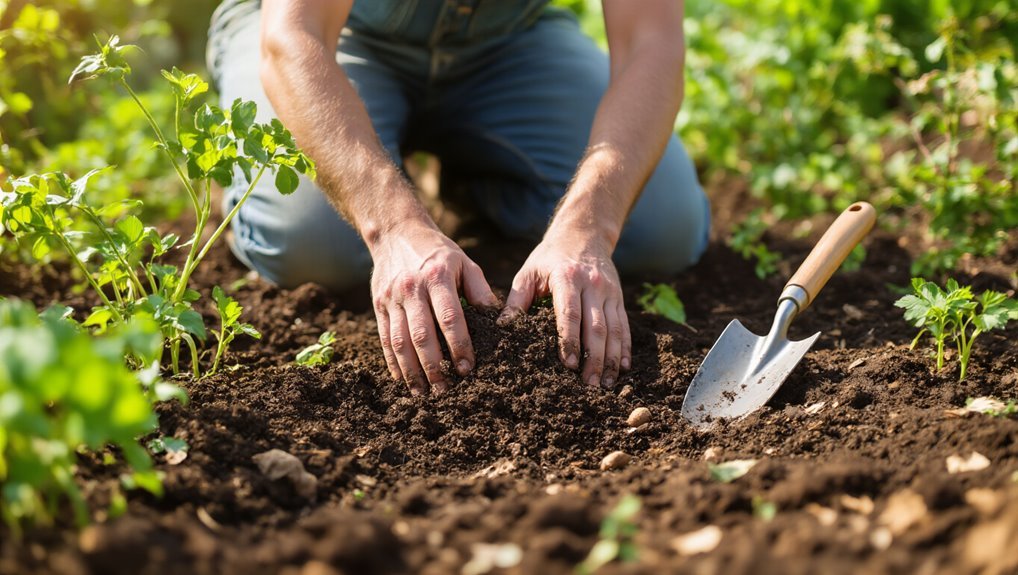
When aiming to improve topsoil, it’s easy to overlook common mistakes that can hinder your progress. Ignoring these pitfalls can lead to frustration and wasted effort.
Here are some mistakes you should avoid:
- Skipping soil tests: Not understanding your soil’s needs can lead to ineffective amendments.
- Over-application of fertilizers: Too much can damage beneficial microorganisms and harm plant health.
- Neglecting organic matter: Failing to add compost or mulch deprives your soil of vital nutrients.
- Compacting soil: Heavy machinery or foot traffic can suffocate roots and hinder water absorption.
- Being impatient: Topsoil improvement takes time; rushing the process can lead to disappointing results.
Frequently Asked Questions
How Long Does It Take to Build Deep Topsoil?
Building deep topsoil takes time, usually several years, depending on your efforts. You can speed up the process by adding organic matter, practicing crop rotation, and minimizing soil disturbance. Consistency’s key to success!
Can Topsoil Be Purchased, and Is It Worth It?
Yes, you can purchase topsoil, and it can be worth it if you need immediate soil improvement. Just ensure it’s high-quality and suitable for your plants to avoid future issues with growth and sustainability.
What Plants Are Best for Improving Topsoil?
So you think you can just sprinkle magic seeds and poof—topsoil improvement? Nope! Try planting legumes, clover, or deep-rooted perennials. They’ll boost nutrients and aerate the soil, making it healthier for your garden.
How Does Climate Affect Topsoil Development?
Climate significantly affects topsoil development. Warmer temperatures can accelerate organic matter decomposition, while excessive rainfall can lead to erosion. You’ll need to adapt your practices based on local climate conditions to maintain healthy topsoil.
Is It Possible to Have Too Much Organic Matter in Topsoil?
Think of topsoil like a sponge—too much organic matter can oversaturate it. You might find water pooling and nutrients locked away, making it tough for plants to thrive. Balance is key for healthy soil!
Conclusion
In your gardening journey, prioritizing topsoil’s transformation is paramount. By fostering fertile foundations, you’ll cultivate a cornucopia of colorful crops. Remember, regularly replenishing rich organic matter and resisting rushed remedies will yield lasting lushness. With patience and persistence, you can create a thriving tapestry of life beneath your plants. So, as you dig into your gardening goals, don’t forget: deep, dynamic topsoil is the key to your garden’s glorious growth!
